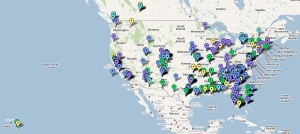A Placemaking Journal
Miami Just the Tip of the Iceberg for Form Based Coding
When Miami, Florida adopted a SmartCode on October 22 by a 4-1 vote, an important step was taken for the global knowledge base of placemaking. This zoning reform is clearly a turning point away from the energy-intensive, environmentally-destructive, auto-centric development patterns of the 20th century. Miami 21 represents the “Miami of the 21st Century,” and takes into account all of the integral factors necessary to make each area within the City a unique, vibrant place to live, learn, work and play. The initiative is the largest mandatory form-based and transect-based unified development ordinance in history.
While this is a massive step for the 4th most populous urbanized area in the U.S., Miami is not alone. About 200 other cities are in the process of zoning reform that utilizes form-based codes to reverse the negative effects of use-based zoning. Use-based codes separate the uses into pods of commercial, residential, industrial, and agricultural. And generally requires an automobile to get from one pod to another. Form-based codes allows a mixture of compatible uses that enable neighborhoods to develop again, nodally along transit corridors.
To get an idea of where all form-based codes are happening, Collaborative Google Maps show the lay of the land. These maps provide an informal support group of SmartCodes and other form-based codes at some point along the process of code writing, adoption, and implementation.
While most of these other initiatives are not on the scale of Miami, several are close, including El Paso, Texas; Denver, Colorado; San Antonio, Texas; Montgomery, Alabama; Memphis, Tennessee; Nashville, Tennessee; Phoenix, Arizona; St. Petersburg, Florida; and Philadelphia, Pennsylvania. On the other end of rural-to-urban transect is the “New Ruralism” that is occurring among the towns and villages that are seeking to deal with sprawling placeless-ness through form-based codes that protect their rural character.
The idea is that by learning from the experience of others, ideas can grow more quickly, and the continental community consensus building power can increase. The maps allow individuals to change their own information, however the general format includes:
– A description of the work at hand
– Links to the draft or final codes
– Illustrations and maps
– Project, client, and consultant websites
– General statistics on adopted codes, including population and acreage
– Links to news articles regarding each initiative
Currently, the maps contain information on 41 adopted SmartCodes, 51 SmartCodes in progress, and 97 other Form-Based Codes. This is not an exhaustive list, as new initiatives begin every day, so everyone is encouraged to add their own work.
Check them all out:
SmartCodes Adopted
SmartCodes in Progress
Other Form Based Codes
Green markers indicate SmartCodes adopted, yellow SmartCodes in progress, and purple other Form-Based Codes.
Additionally, TND maps give details on projects that are being designed in form-based development patterns. While many of these projects were done without the benefit of form-based codes but rather as Planned Unit Developments (PUDs), others are designed under adopted form-based codes. These maps are intentionally not a ranking or review system, however turning on satellite view and zooming in is an instructive virtual tour on the successes and challenges of thse developments.
All of these maps may be opened simultaneously, to get a regional idea of the sorts of initiatives that are occurring across the continent. When traveling to a particular region, the maps become a tour guide for progressive urbanism and zoning reform.
TNDs US – West
TNDs US – East
TNDs US – Florida & Caribbean
TNDs Canada
For TNDs, blue markers indicate greenfield development, and turquoise for infill, brownfield and grayfield.
— Hazel Borys









